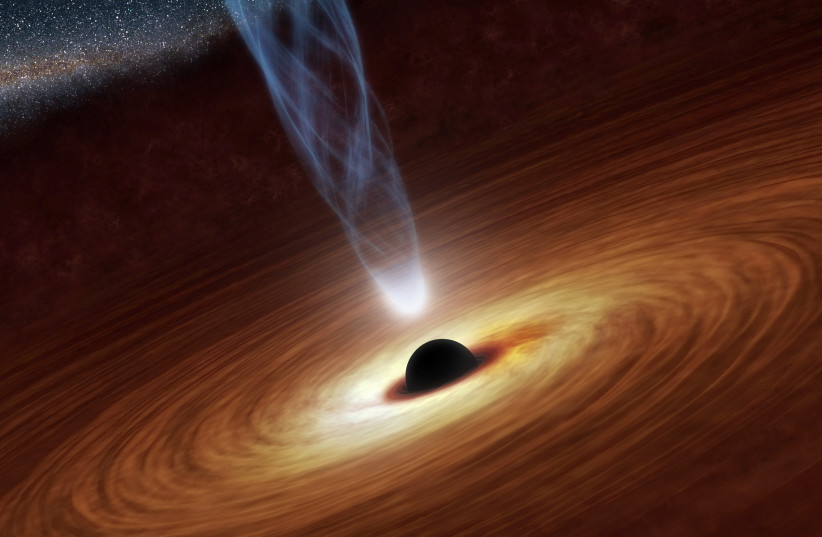When most people think of black holes, they think of the huge concentrations of gravity in space ruthlessly devouring unfortunate stars or planets that veered too close to them. But originally, these enigmatic sources of cosmic destruction actually created stars, according to a new study.
This research was carried out by a team of scientists led by John Hopkins University Prof. Joseph Silk and was made possible by NASA's James Webb Space Telescope.
The findings of this study were published in the peer-reviewed academic periodical The Astrophysical Journal Letters, and threaten to practically rewrite the scientific understanding of black holes.
Black holes: From star creator to cosmic devourer
Black holes, in general, are incredibly mysterious. They are, in essence, just massive concentrations of gravity so strong that nothing, not even light, is able to escape, which makes them invisible. The only way scientists can even tell if one exists is based on the gravitational pull it has on matter all around it. Some of these black holes are even larger, called supermassive black holes, which sit at the center of most galaxies and are thought to play a key role in galaxy formation.
Previous research concluded that there are around 40 quadrillion black holes in the observable universe, and these form when a large star dies. This understanding plays a key role in our scientific understanding of the universe. Originally, stars would form out of gas and minerals. Then, over billions of years, these stars would be pulled together and slowly form galaxies. At the end of their life, these stars would collapse and form black holes, with the death of a star triggering a supernova that would send more gas and minerals throughout the cosmos, where they could be used to form new stars. The black holes in these galaxies, specifically the supermassive black holes at the center, would serve to balance the galaxy by tempering star formation.

At least, that was what we thought.
But this new study has thrown a wrench into all of this, all thanks to some little red dots.
Scientists look back in time
The James Webb Space Telescope is equipped with instruments so sophisticated they can look back in time. This is because of the relationship between time and distance.
For example, the Sun is, on average, 150 million kilometers away from the Earth. Now, one might think that all sunlight that reaches Earth does so instantaneously, but that actually isn't true. Light has a set speed it can travel (specifically 299,792,458 meters per second, assuming it is traveling in a vacuum without any interference). This is very fast, but it isn't instantaneous.
With this speed in mind, we know that it takes light from the Sun a little over eight minutes to reach Earth. That means when we look at the Sun, we aren't seeing a live image of what is actually happening on the Sun. We're actually seeing what was happening on the Sun around eight minutes prior.
Now take this idea and expand the scale so it applies across the universe. All stars emit light, which we can see. But the farther away the star is, the older what we're seeing is. If you're looking at a very distant star, you're actually seeing what happened a very long time ago.
This is how the James Webb Space Telescope can, essentially, see back in time.
One thing they found was a series of small, red dots, which scientists have concluded are some of the earliest galaxies to have ever formed.
Further analysis concluded that these early galaxies seem to already have supermassive black holes of their own. Specifically, they are seen with quasars, one of the brightest objects in the universe, so bright that they completely outshine the galaxy around them.
But based on how we know stars and galaxies evolved, that shouldn't have been happening.
So how is this possible?
According to one of the writers of this study, University of Colorado Boulder Prof. Mitch Begelman, it isn't.
The only explanation is that the black holes must have come first, before the galaxies did.
"We know these monster black holes exist at the center of galaxies near our Milky Way, but the big surprise now is that they were present at the beginning of the universe as well and were almost like building blocks or seeds for early galaxies," Silk said in a statement. "They really boosted everything, like gigantic amplifiers of star formation, which is a whole turnaround of what we thought possible before."
The theory goes that black holes are basically responsible for stars forming in the first place. Black holes would reside inside giant gas clouds, which would collapse. The black holes would help turn the inner part of the coud into stars.
The idea of black holes creating stars isn't unprecedented. Back in 2023, scientists noted a supermassive black hole that seemed to had been ejected from its galaxy and was flying alone through space. As it would pass through gas though, it wouldn't be able to devour them due to moving so fast, but rather would end up creating new stars.
But how does this switch over? Well, the scientists have a theory. Essentially, star formation and black hole formation amplify each other, a process dubbed positive feedback.
"We're saying that the growth of the black hole, at first, promotes the stars. And only later, when conditions change, does it flip into a mode of turning off the stars," Begelman said.
Silk elaborated: "Star formation accelerates massive black hole formation, and vice versa, in an inextricably connected interplay of violence, birth, and death that is the new beacon of galaxy formation."
This revelation naturally raises many more questions. But given that the James Webb Space Telescope has proven it can find these ancient black holes from the early years of the universe, it seems further research on the subject is inevitable.
